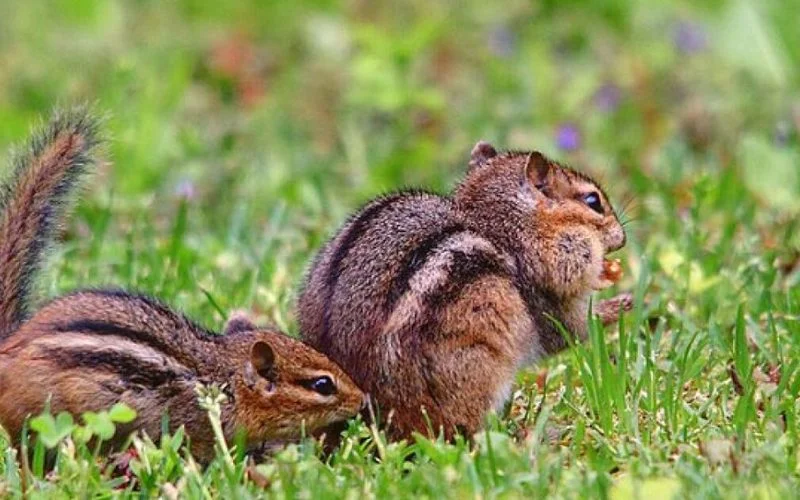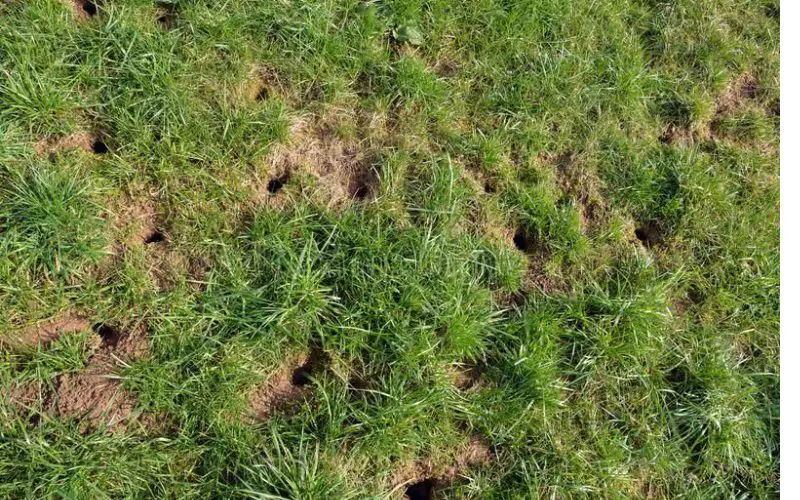Can you remember how excited you felt when you first noticed a chipmunk in your yard? You were probably amazed, but as days pass, this excitement is replaced by annoyance because those cute little critters have buried holes everywhere around your yard and are ruining it. Chipmunks can make burrows that extend 20–30 ft (6.1–9.1 m) underground,
You can take care of these holes in your yard by simply filling them with gravel, sand, or cement. The idea is to keep these pesky animals from creating tunnels around our homes. If you are tired of the carnage these little animals cause, get rid of their food from your yard, and they will vanish.
Some Chipmunk Facts

Chipmunks which belong to the family Sciuridae have more than 25 species globally, each with its characteristic trait and behavior.
Still, generally, they are 2 to 6 inches long, while some have up to 3 inches long tails. These tiny creatures usually weigh less than a pound, with some species as little as 35 grams, and their life span is usually 2 to 3 years.
They come in different colors and stripes: while some have shades of brown fur, others have yellow or grey fur with black and white stripes on their back.
Chipmunks are native to North America, except the Siberian chipmunk, which is found in the eastern half of the United States and Canada, and it is the only specie that is found outside the continent of North America.
Chipmunks live in areas with a lot of ground cover that shields them from predators, so many of them will live in urban areas with enough cover, like in hedges, parks, and people’s houses.
At the same time, the main habitats are usually deciduous forests, bushland, and woodlands, where they live in tree stumps, shrubs, and rocks.
Chipmunks love to burrow as they search for food and shelter; they make shallow burrows for foraging and have pouches inside of their cheeks where they store food when foraging.
They also make deeper caves, but they are for nesting. They are omnivores that eat diverse food, especially during warm months. One tiny chipmunk can gather about 165 acorns in a day while they hoard the seeds and nuts they have gathered to eat in winter. Reproduction in chipmunks happens twice a year, usually in spring and summer, and they give birth to 4 to 5 babies at a time.
How To Identify Chipmunk Damage
Even though chipmunks are small animals, the nuisance they cause can be enormous. As they burrow, they cause a lot of damage, which can even affect the structural integrity of your home.
So if you notice holes in your lawn or garden resulting from digging plant roots, or you see uprooted bulbs of root plants, you probably have chipmunks to blame for that.
If you suspect that chipmunks are creating havoc in your space, one way to be sure is to watch out for their tiny prints of tracks in your yard. If you notice that the prints show four toes in the front while the back print shows five toes, they most likely are chipmunk tracks because their front and hind feet are generally reversed.
The holes chipmunks make are small because they don’t want something that can be easily noticed. The entrance to the holes is about 2 inches in diameter, and they gently slope downwards, and these holes can be found in any part of the yard.
Chipmunks don’t gather or pile dirt around the entrance of their holes. They take the dirt away with their cheeks and then deposit it elsewhere.
How to Fill Chipmunk Holes

Chipmunks can dig through dirt, but it is a challenge for them to dig through sand, gravel, and hard materials like that, so if you fill chipmunk holes with these materials, then they are most likely not to dig it up because they can’t carry the dug out debris.
Before you attempt to fill a chipmunk hole, you must understand that one hole can have more than one entrance, so much so that when you film one entrance, they can still get into the hole through another. Hence, it would be best to fill all the entrances to chase them away effectively. Here are ways to fill holes that chipmunks dig.
Fill The Hole With Gravel
It is one of the most practical ways of filling a chipmunk hole. In choosing gravels, go for ones that are small, no bigger than a pea; this is important because if the gravels are extensive in size, they might have some spaces when you fill the hole up, and the chipmunks might try to get the gravels out through those spaces.
If the gravels are small, it will shift and still fill the space when the chipmunks try to remove them.
To fill chipmunk holes with gravel, get gravel about a quarter of an inch in size, locate the entrances, and then use a funnel to pour the gravel into the hole’s entrance.
Ensure you push the gravel deeper into the hole using a hand tool like a screwdriver to get to the bottom. If the gravel gets as deep as 4 to 6 inches, you can be sure that chipmunks cannot get them all out.
Fill Chipmunk Holes with Sand
Sand is another good material for filling a chipmunk hole because if a chipmunk wants to get the sand out of the hole, the sand will slide and still fill up the hole; this can be discouraging and cause them to give up their quest.
You fill the chipmunk hole with sand using a funnel just the same way you fill the hole with gravel, but in this case, you will use coarse sand until it levels with the surface of the soil.
Fill Chipmunk Holes with Cement
If you have tried gravel and sand to fill the holes made by chipmunks, and they still reopen those holes, it is time to bring the big guns: cement. Cement provides a foolproof (or better still, chipmunk-proof) means of permanently closing a hole dug by chipmunks.
To fill the hole, you should get pre-mixed cement and then use a simple hand tool or even a stick to push the cement through the hole entrance until it gets to the bottom.
Ensure that the cement is well packed to keep the space. Do not fill the hole with cement; leave about 2 inches at the hole’s entrance, which you will cover with dirt. This dirt means grass and other plants can grow on that spot, the chipmunks’ final nail in the coffin.
Fill The Hole with Cat Litter
Cats are cute animals, too, but they are natural predators of chipmunks, so if there is anything in your space that shows that you have cats in your home, it will cause chipmunks to steer clear from such places.
Many people pour cat urine or litter around their homes to deter chipmunks from invading; this is an effective and cheap means of getting the job done.
You can fill the hole dug by chipmunks with cat litter to scare those critters from reopening the holes because they will think that cats are around and might hunt them, which will cause them to flee your home.
Be careful when using this cat litter around your plants because the high ammonia content can harm your plant.
Please Don’t Use Liquids And Chemicals
Many people employ home remedies to care for chipmunks and the holes in their homes. It includes using materials like bleach, mothballs, gasoline, and what have you in chasing chipmunks out of the holes and their homes. Aside from the fact that these methods are not very effective, they are also not environmentally friendly.
These substances can kill the microbes in the soil, thereby rendering the soil nutrient deficient. In some parts of the United States, it is illegal to use these liquids to ward off the menace of chipmunks because these chemicals can contaminate the local water supply and contaminate it.
Conclusion
Chipmunks are some of the cutest animals, especially with their fluffy bodies and beautiful colors. Still, they are very destructive animals that must be evicted from the deep holes they have made around your home.
Read Also:
- Do Skunks Climb Trees or Fences?
- How High Can a Raccoon Jump
- What Sorts of Food Does Backyard Lizard Eat?
- What Do Backyard Bunnies Eat?
The soundest way to do this is to fill up their burrows, where they nest with sand, gravel, cement, or cat litter. It will undoubtedly cause them to seek food and shelter somewhere far from your home.
If you liked this article, then please follow us on Facebook, Instagram, and Pinterest.

![How to Fill Chipmunk Holes [4 Easy Methods]](https://www.backyardcaring.com/wp-content/uploads/2022/11/How-to-Fill-Chipmunk-Holes-4-Easy-Methods.jpg)